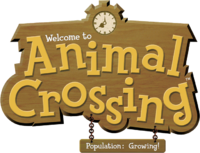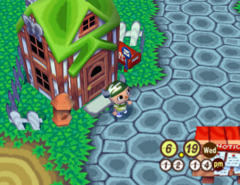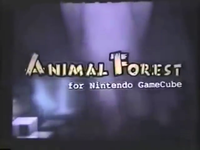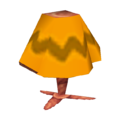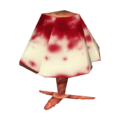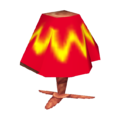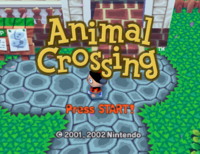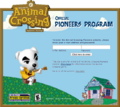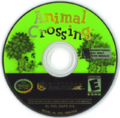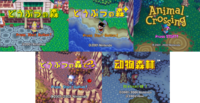Animal Crossing
| ||||||
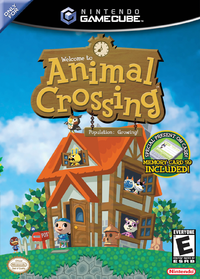 | ||||||
| Main theme | ||||||
|---|---|---|---|---|---|---|
| Developer(s) | Nintendo EAD | |||||
| Publisher(s) | Nintendo | |||||
| Director(s) | Katsuya Eguchi Hisashi Nogami | |||||
| Platform(s) | Nintendo GameCube | |||||
| Release date(s) | ||||||
| Genre(s) | Simulation | |||||
| Language(s) | ||||||
| Modes | Single-player | |||||
| Ratings | ||||||
| Media | GameCube Game Disc | |||||
| File size | 57 blocks (town save data) 3 blocks (travel data) 1 block (NES save data) | |||||
| Input methods |
Nintendo GameCube Controller Game Boy Advance (Animal Island only) e-Reader | |||||
Animal Crossing is a simulation game for the Nintendo GameCube released on September 16, 2002, and the first game in the Animal Crossing series to be localized for Western audiences. Animal Crossing is the international release of Doubutsu no Mori+, released in Japan on December 14, 2001, itself an expanded port of the Nintendo 64 game Doubutsu no Mori, which had been released just eight months prior. Animal Crossing adds new content and utilizes the Nintendo GameCube's internal clock to keep track of the in-game date and time. The game's newly added content includes a tropical island where players can help a local islander furnish their house, a museum for donating collectibles, a tailor where players can create custom designs, and compatibility with the e-Reader through a series of cards released specifically for the game.
The game was released in North America in 2002. To prepare the game for release, Nintendo of America embarked on an extensive localization, headed by Nate Bihldorff and Rich Amtower. Their efforts resulted in a substantial increase of in-game text compared to Doubutsu no Mori, and the change of many distinctly-Japanese cultural elements to make them more recognizable to a western audience. Additional content was implemented, such as entirely new holidays, items, and characters. Certain events were also changed to have broader appeal in western regions. This version of the game was also later released in Australia in 2003, and across Europe in 2004.
Animal Crossing was a commercial and critical success, selling more than 2 million copies worldwide and garnering strong reviews from gaming media. The game became a Player's Choice title in North America. Due to the successful localization effort, the game was translated back into Japanese and released in Japan as Doubutsu no Mori e+, which features the western-oriented changes as well as additional content not present in any of the previous versions.
Gameplay[edit]
Just as in Doubutsu no Mori, players assume the role of a human setting out for a life of their own in a town of anthropomorphic animals. Each town is randomly generated, ensuring that no two players' experiences are identical. Gameplay within each village is open-ended, allowing players to engage in a variety of activities that suit their playstyle. Players can pick fruit, grow trees, garden, hunt for fossils and fish, catch bugs, do favors for the villagers, or decorate their homes.
Plot[edit]
Upon arrival to the town, the player is greeted by Tom Nook, a local store owner and freelance builder who provides the player with housing. Nook loans the house to the player, advising them to work for him to help pay off the house. After completing several tasks for Nook, he informs the player that they no longer need to work for him and can pay off the loan in their own time. After paying off the loan, Nook allows the player to expand their house in exchange for a new loan. After fully expanding the house and paying back all loans, Nook builds a statue of the player in their honor in front of the train station.
Controls[edit]
| Input | Result |
|---|---|
| |
| |
| |
| |
| |
| |
| |
| |
|
Development[edit]
The Nintendo of America localization team began writing game dialogue in early 2002; however, translation of the game's hundreds of items began months earlier.[2] Unlike the extended localization and development process for recent titles in the series, Animal Crossing was localized in the span of eight to twelve months. During this time, the team translated over 30,000 files of text,[3] worked to develop new items and events to appeal to a North American audience.
In contrast to a usual localization, Animal Crossing required not only significant rewriting, but replacing and addition of new contents. Doubutsu no Mori+ heavily featured elements from Japanese culture, and the developers wanted American audiences to have a similar experience.[2][4] As detailed in an interview with Nate Bihldorff and Bill Trinen, the localization team conceptualized new events and items, and sent them to the developers in Japan to implement them in the game. The final addition was the summer camping event, which was worked on collaboratively in-person during E3 2002, a few months before the game's release, when the development team offered to add more content. The localizers also faced some difficulties over the portrayal of Gracie's gender, as well as confusion over that of Saharah and Blanca. The flexibility of the actual script allowed them to insert their own voice or jokes, with the tasks of localizing each villager personality split among different members for consistency. According to Trinen, the team in Japan was so impressed with the changed and additional content of the localization that they decided to re-release the localized version of the game in Japan,[4] in what would become Doubutsu no Mori e+.
Announcement and release[edit]
In April 2001, shortly after the release of Doubutsu no Mori and eight months before the release of Doubutsu no Mori+, producer Takashi Tezuka stated in an issue of Nintendo Dream that Nintendo of America was preparing for an international release.[5] The following month, on May 16, 2001[6] at Nintendo's pre-E3 press conference, a six-second montage of gameplay footage from what was then known as Animal Forest was shown to members of the media as part of a larger reel featuring upcoming Nintendo GameCube titles.[7] The clip did not feature any dialogue, however the presence of the shrine indicates that it was still early in the localization process, if not footage directly from the Japanese version.
As early as October 2001,[8] Nintendo established a page on their website for Animal Forest noting it was "being optimized for its U.S. debut on the GameCube."[9] A few months later on February 28, 2002, at a Nintendo Roundtable Conference, Shigeru Miyamoto confirmed that localization of Animal Forest was "progressing and moving along quite well" with then-Nintendo president Satoru Iwata projecting it to be released "sometime in the fall."[10] About a month later on March 30, 2002, the game's name was officially changed to Animal Crossing,[11] as reflected on Nintendo's website at the time.
On May 22, 2002, at Nintendo's pre-E3 press conference, an extended video was shown introducing Animal Crossing and highlighting its ability to connect with the e-Reader and Game Boy Advance.[12] Iwata also confirmed the game for September release in North America. Later that day, Animal Crossing made its second E3 appearance, this time as a playable title on the show floor.[3] It was generally overshadowed by high-profile titles, however it still received the third-place spot on the Game Critic Award's list for Best Original Game of E3 2002.[13] Animal Crossing was released in North America on September 16, 2002.[14][15][1] There were reports, however, that select Blockbuster Video locations had received and began renting advance copies of the game as early as September 6.[16]
Australian and European release[edit]
Animal Crossing was released on October 17, 2003 and September 24, 2004 in Australia and Europe, respectively. Both versions feature minor bug fixes from the North American release, and the European release features localizations in French, German, Italian, and Spanish.
Further details: Needs info about the Japanese DnM+ development + research into release date(s) in South American countries is needed. Starting point: Research South American distribution by Latamel Inc.
Further details: Needs info about the Japanese DnM+ development + research into release date(s) in South American countries is needed. Starting point: Research South American distribution by Latamel Inc.
Regional differences[edit]
Japan to North America[edit]
In addition to being an upgraded re-release to the original Doubutsu no Mori, there are also many differences between the Japanese Doubutsu no Mori+ and international Animal Crossing.
Interface[edit]
- The dial typing system, featured in Doubutsu no Mori, is retained in the Japanese version of Animal Crossing game, although it is replaced with a virtual QWERTY keyboard in the international versions.
- The color of the Nintendo logo differs between versions. In the Japanese version, it is white, while in the international version it is red.
- The "Press START!" text on the title screen reads "Press Start Button!" in the Japanese version.
- The copyright text on the title screen reads "©2001 Nintendo" in the Japanese version; this was changed to "©2001,2002 Nintendo" in the North American release.
Locations[edit]
- The shrine from the original game is changed in the international version to be a wishing well.
- Tom Nook's shop, the Melody Board, and the dump all have different signs. In the Japanese version, the signs feature katakana but are replaced with English text in the international version.
- The exterior of Nookington's is considerably redesigned, featuring a new canopy and marquee, a new building surface, and a large window in place of the sales banners. The clothing display window is also repositioned and given a new border.
- The Japanese postal mark (〒) above the post office entrance is changed to a window in the international version.
- The sign above the entrance of the police station, which features Japanese text and a star in the center, is changed to "POLICE" in the international version. Additionally, the sign to the left of the entrance is removed and the poster on the side is changed from a wanted poster featuring six individuals, one of which is crossed out, to a single animal.
- Redd's stand during the Fireworks Festival has a completely different appearance between versions. In Doubutsu no Mori it is enclosed by red canvas walls on three sides with a sign above the front side of the stall. In the international version, it is open on all sides, with a red and white-striped pitched roof and more visible decorations but no signage.
- Igloos contain woks with bubbling blocks of tofu in the Japanese version, which is changed to a pot of chowder in the international.
- The orange-roofed player house has a worn-out dirt wall and old board floor instead of wood paneling and steel flooring.
Characters[edit]
- All of the possible player face textures have black eyes in the Japanese version. In the international version, six of the eight faces for each gender are given colored eyes. This design choice is retained in other Japanese releases until the release of Animal Crossing: Happy Home Designer.
- Farley and Franklin are new characters introduced in the international version that do not exist in the Japanese version.
- Various existing characters were redesigned in the international version, and their redesigns have been kept in all subsequent games in all regions.
- Tortimer wears glasses with white blue lenses and a red zucchetto in the Japanese version. He also wears a white rope around his chest.
- Mr. Resetti and Don Resetti simply wear white shirts in the Japanese version and wear overalls on top of the shirts in the international version. Additionally, Mr. Resetti's mining helmet features a green stripe under the headlight, while Don Resetti's is green with a white stripe.
- Tom Nook and Redd both have Japanese characters on their aprons. In the international version, Tom Nook's apron is instead emblazoned with his logo, and Redd's apron features the letter B. Tom Nook's apron in the Japanese version displays the character ten (店), meaning "shop."
- The uniforms for Tom Nook's uniform in Nook 'n' Go and Nookway were reversed for the international version. His Nook 'n' Go uniform is an apron with a blue and orange color scheme, which is changed to red and green and used for Nookway in the international version. His Nookway uniform is changed to the opposite. This was most likely done to avoid infringing on the color scheme for 7-Eleven, of which the original Nookway uniform resembles.
- Tom Nook's raffle uniform in the Japanese version is a red and black Haori with a white Hachimaki tied around his head, while in the international version it is changed to a tricolor apron with a sports visor.
- Redd's uniform during the Fireworks Show is completely different in both versions. In the Japanese version, he wears a red and white Hachimaki with a feather attached, and a deep-blue Haori over his usual apron. In the international version, he wears a sports visor and full-length apron with red and white stripes and the letter B emblazoned on it.
- Chip in the Japanese version has distinctly brown fur, with narrow eyes, glasses, and a purple vest. In the international version, Chip's eyes were made wider, his vest was changed to blue with green trim, and his glasses were removed.
- On New Year's Day, Katrina dresses on some occasions in the Japanese version in a traditional Japanese Hakama, with her head fully exposed and a white band on her forehead, as well as sometimes wearing her traditional purple robes. In the international version, Katrina exclusively wears her purple robes.
- Copper and Booker have lighter shirts and hats with slightly different texturing. Additionally, the badge on their hats is a different design, and there is no badge on their shirts.
- In the Japanese version, Aziz and Elina each has a dot on their forehead that resembles a bindi, a decoration traditionally worn by Hindus and Jains from the Indian subcontinent. Both were removed from international releases; however, Elina's dot still appears on her Game Boy Advance sprite.
- In the Japanese version, Jane has white fur and brown skin. In international releases, she has purple fur and pink skin.
Altered character designs[edit]
| Name | Doubutsu no Mori+ | Animal Crossing |
|---|---|---|
| Player (boy AAB) |
 |
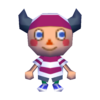
|
| Player (boy ABB) |
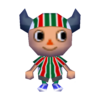 |
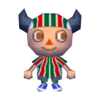
|
| Player (boy BAA) |
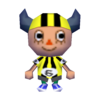 |
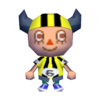
|
| Player (boy BAB) |
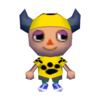 |
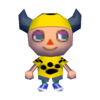
|
| Player (boy BBA) |
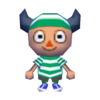 |
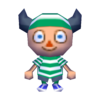
|
| Player (boy BBB) |
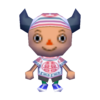 |
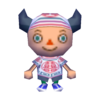
|
| Player (girl AAB) |
 |
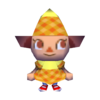
|
| Player (girl ABA) |
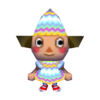 |
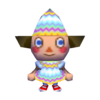
|
| Player (girl ABB) |
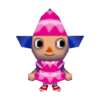 |

|
| Player (girl BAA) |
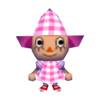 |

|
| Player (girl BAB) |
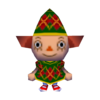 |
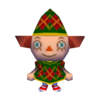
|
| Player (girl BBA) |
 |
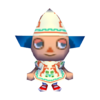
|
| Aziz | 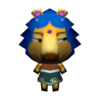 |
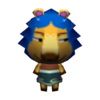
|
| Booker | 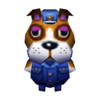 |
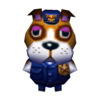
|
| Chip |  |
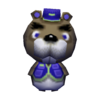
|
| Copper | 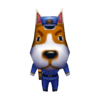 |
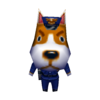
|
| Don Resetti | 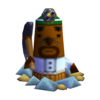 |
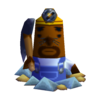
|
| Elina |  |

|
| Hambo | 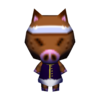 |
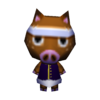
|
| Katrina (New Year's Day) |
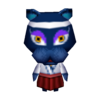 |

|
| Jane | 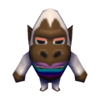 |

|
| Mr. Resetti | 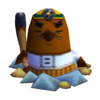 |
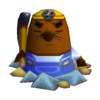
|
| Redd | 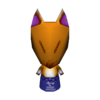 |
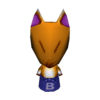
|
| Redd (Fireworks Festival) |
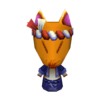 |
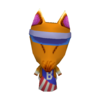
|
| Tom Nook | 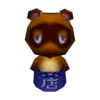 |
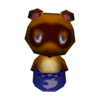
|
| Tom Nook (Nook 'n' Go) |
 |
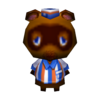
|
| Tom Nook (Nookway) |
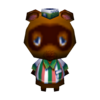 |
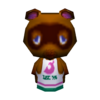
|
| Tom Nook (raffle) |
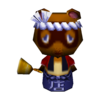 |

|
| Tortimer | 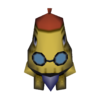 |
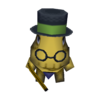
|
Villagers with changed default clothing[edit]
| Name | Doubutsu no Mori+ | Animal Crossing |
|---|---|---|
| Cesar | 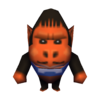 A shirt |
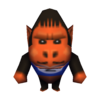 Two-ball shirt |
| Cousteau | 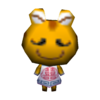 Noodle shirt |
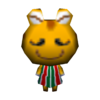 Rally shirt |
| Grizzly | 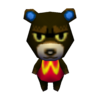 W shirt |
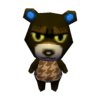 Houndstooth tee |
| Paolo | 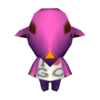 I love GC shirt |
 Cherry shirt |
| Punchy |  I love GC shirt |
 Cherry shirt |
| Rasher |  Familiar shirt |
 Fortune shirt |
| Tabby | 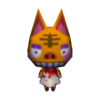 Tomato juice shirt |
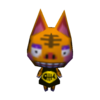 Fish bone shirt |
Events[edit]
- Many of the events found in the Japanese version are changed for or removed from the international version.
- Seven Spring Herbs Day, Coming of Age Day, Bean-Throwing Festival, White Day, Festival of the Weaver, Summer Day, and Winter Day are exclusive to the Japanese version.
- Groundhog Day, Valentine's Day, April Fool's Day, Founder's Day, Explorer's Day, the Harvest Festival, and Sale Day are all exclusive to the international version.
- In the Japanese version, villagers will wear the Summer Robe and Bamboo Robe during the Fireworks Show and Mushrooming Season. They will also wear the Plum Kimono and Somber Robe during certain other events. In Animal Crossing, all of these clothing items are not used or legitimately obtainable, though they still exist in data.
- On New Year's Day, the player shakes a pole in the middle of the shrine to ring the bell. In the international version, this is changed to the player tossing a coin in the wishing well's fountain.
- During the Cherry Blossom Festival, villagers will picnic on tatami mats at the shrine. In the international version, the mats are changed to picnic tables and the villagers dance around the wishing well.
Items[edit]
- Several furniture sets are different compared to the international version:
- The Publicbath Theme is only present in Doubutsu no Mori, this game's Japanese version, and returns in Doubutsu no Mori e+. It is completely removed from the international version and is also absent from Wild World. It returns in games from City Folk onwards for all regions, but it is no longer a theme.
- The Japanese Theme is only present Doubutsu no Mori, this game's Japanese version, and Doubutsu no Mori e+. It returns from Wild World-onwards under a different name for all regions but as a set rather than a theme.
- The School Theme contains different items in the international version.
- The Construction Theme contains different items in the international version.
- The Harvest Series and numerous holiday items are absent as they are exclusive to the international version.
- The Boxing Theme, Backyard Theme, and Western Theme have been added in the international version.
- There are many differences with the availability of Famicom Disk System (FDS) and Nintendo Entertainment System (NES) games between versions.
- The Japanese version features the Famicom games Gomoku Narabe and Mahjong, while in the international version these games are changed to the NES games Soccer and Excitebike.
- Ice Climber would be received as a "housewarming gift" after using the service to transfer save data from Doubutsu no Mori to this game's Japanese version. In the international version, it can only be acquired through an Animal Crossing-e Series 4 card.
- The Japanese version features the Famicom Disk System version of The Legend of Zelda. The game is changed to the NES version in the international version, though the game is not legitimately obtainable in either version.
- Four shirts are unique to the Japanese version, having been redesigned in Animal Crossing:
- I love GC shirt (redesigned as the cherry shirt — Worn by Paolo and Punchy)
- Familiar shirt (redesigned as the fortune shirt — Worn by Rasher)
- Tomato juice shirt (redesigned as the fish bone shirt — Worn by Tabby)
- W shirt (redesigned as the houndstooth tee — Worn by Grizzly)
- The fortune paper and new year's card stationery have a different visual appearance in the international version.
Miscellaneous[edit]
- The live version of "DJ K.K." contains guitar riffs resembling the song "Get Ready for This" by 2 Unlimited. In the international version, this is changed to an original melody.
North America to Australia and Europe[edit]
Several minor changes were made to Animal Crossing in its Australian and European versions. In addition to these changes, both versions include various bug fixes from the North American version.
Australia[edit]
- The font for the copyright text on the title screen was changed, and it now reads "©2001-2003 Nintendo" to reflect the game's release date in Australia.
- The Mario trophy and Luigi trophy have shorter bases. This is carried over from Doubutsu no Mori e+.
- The ROMs for Golf, Pinball, Punch-Out!!, Soccer, and Wario's Woods have been changed to their European versions.
- The following dialog entries have been changed to fix typos or formatting errors (changes in bold):
| Entry ID | North America | Australia | Notes |
|---|---|---|---|
| 0788 |
"Oh, Wait a minute! |
"Oh, wait a minute! |
|
| 078E |
"That price is rock bottom! |
"That price is rock bottom! |
|
| 0D69 |
"So, <player>, |
"So, <player>... |
|
| 1103 |
"Hold it! This is no bass! |
"Hold it! This is no bass! |
|
| 1300 |
"I feel so silly. |
"I feel so silly. |
Item name is not pluralized, leading to a grammatical error in the North American version. |
| 1410 |
"I see. Well, I've got to get |
"I see. Well, I've got to get |
|
| 14A4 |
"No big deal. Anyway, I'm |
"No big deal. Anyway, I'm |
|
| 1D54 |
"In an hour, it'll be <time>... |
"In an hour, it'll be <time>... |
|
| 321B |
"Oh, my! <player>! |
"Oh, my! <player>! |
Double space after "time" in the North American version. |
| 3A4C |
"So, Sonny had an urgent |
"So, Sonny had an urgent |
|
| 3A6B |
"Let's me make one thing |
"Let me make one thing |
|
| 3B20 |
"You need to insert a different |
"You need to insert a different |
|
| 3B3D |
"The Memory Card in<Slot A/Slot B> |
"The Memory Card in <Slot A/Slot B> |
- The lengths of the pauses between words during Kapp'n's Song have been adjusted.
- The spelling of two names in the credits has been fixed: "Tim O'Leary" ("Tim O'leary" in the North American version) and "Robert Crombie" ("Robert Cromble" in the North American version).
Europe[edit]
- French, German, Italian, and Spanish languages are supported, and the language used by the game is dependent on the GameCube's language.
- All e-Reader functionality (and references to it) has been removed, as the e-Reader was never released in Europe. This means the Ice Climber and Mario Bros items are unobtainable, though they still exist in the game's code. Despite this, the item names still received translations.
- The "Press START!" text on the title screen now reads "press START", and the font has been changed.
- The font for the copyright text on the title screen was changed, and it now reads "©2001-2004 Nintendo" to reflect the game's release date in Europe.
- The clock uses the 24-hour format rather than the 12-hour format used in the North American version, and all in-game dialogue is updated to reflect this.
- Dates use the Day/Month format rather than the Month/Day format used in the North American version.
- Pounds, in the context of weight, is replaced by kg.
- Numbers use periods instead of commas as decimal separators (e.g. 1.000 rather than 1,000).
- The sign in front of the dump features a fish-bone design in non-English language versions rather than the text "Dump."
- Spring Cleaning Day occurs on March 15 instead of May 1.
- Labor Day occurs on May 1 instead of the first Monday of September.
- The chalk board reads "English Lesson" instead of "Social Study."
- The Mario Trophy and Luigi Trophy have shorter bases. This is carried over from Doubutsu no Mori e+.
- The ROMs for Golf, Pinball, Punch-Out!!, Soccer, and Wario's Woods have been changed to their European versions.
Promotion[edit]
Animal Crossing Pioneers[edit]
On August 7, 2002, Nintendo of America announced a contest whereby 125 teams of two would be selected to receive advance promotional copies of Animal Crossing.[1] The submission deadline for the contest was August 12th. To be considered for selection, applicants had to submit a written response of 50 words or less explaining why they should be chosen as Pioneers. Those selected received a special Animal Crossing disc marked "for promotional use only," along with a 59 block Memory Card and a promotional Animal Crossing calendar. Pioneers received the game a month early and were expected to help Nintendo generate online buzz in advance of the title's release. Pioneers were also given exclusive access to a web forum where they could discuss the game amongst themselves as well as provide feedback to Nintendo representatives. At the end of the experience, the Pioneers were invited to an online chat with a few of the members of the game's localization team.[17] An analysis of the standard and promotional game disc concluded that the two were byte identical,[18] meaning that no changes were made to the final version as a result of Pioneer feedback. The promotional copy and calendar have since become collector's items, with one set selling for over $500 on eBay in March 2014.[19]
Sweepstakes[edit]
From August 30 to October 15, 2002, Nintendo of America initiated the Animal Crossing "Deck Out Your Room" Sweepstakes.[20] One grand prize winner received a TV, headphones, and CD player from Panasonic, a Nintendo GameCube, a Game Boy Advance, five GameCube games, five Game Boy Advance Games, two WaveBird controllers, and a one-year subscription to Nintendo Power. Five first prize winners received a Nintendo GameCube, a copy of Animal Crossing, and a one-year subscription to Nintendo Power.[21] Those who registered for the sweepstakes received a free Animal Crossing screensaver.[22]
Reception[edit]
Animal Crossing was met with mostly positive reviews from critics, with many praising its charming, unique gameplay and long life span. e-Reader connectivity was seen as a welcome addition, although some criticized its outdated graphics and felt that it did not offer much of a single-player experience.[citation needed]
Animal Crossing was included in many year-end 'best of' lists upon its release in 2002. It has also been featured in several all-time top video game countdowns and has received multiple awards and nominations. Review aggregator Metacritic notes a Metascore of 87/100 for Animal Crossing,[23] which places it just behind Animal Crossing: New Leaf's score of 88. In May 2021, Animal Crossing was inducted into the World Video Game Hall of Fame.[24]
Awards and nominations[edit]
| Year | Award | Category | Result | Ref. |
|---|---|---|---|---|
| 2002 | Game Critic Award | Best Original Game of E3 | Nominated | [13] |
| GameSpot's Best and Worst of 2002 | Game of the Year | Nominated | [25] | |
| Best Role-Playing Game on GameCube | Won | [26] | ||
| Most Innovative Game | Won | [27] | ||
| Funniest Game (Purposely) | Nominated | [28] | ||
| GameSpy's Best of 2002 | GameCube Game of the Year | Nominated | [29] | |
| 2003 | The Game Developers Choice Awards | Innovation Award | Won | [30] |
| Interactive Achievement Awards | Innovation in Console Gaming | Won | [31] | |
| Outstanding Achievement in Game Design | Won | [31] | ||
| Console Role-Playing Game of the Year | Won | [31] | ||
| Console Game of the Year | Nominated | [31] | ||
| Game of the Year | Nominated | [31] | ||
| Outstanding Achievement in Gameplay Engineering | Nominated | [31] |
Top lists[edit]
| Year | Publication | List | Placement | Ref. |
|---|---|---|---|---|
| 2003 | Nintendo Power | Nintendo Power's All-Time Console Favorites | 17 | [citation needed] |
| Entertainment Weekly | The 100 Greatest Videogames | 72 | [32] | |
| 2006 | Electronic Gaming Monthly | The Greatest 200 Videogames of Their Time | 126 | [33] |
| Nintendo Power | Nintendo Power's Top 200 Games | 51 | [34] | |
| X-Play | 10 Best GameCube Games Ever | 7 | [35] | |
| 2007 | Edge | Top 100 Games of All Time | 49 | [36] |
| ScrewAttack! | Top 10 GameCube Games | 5 | [37] | |
| 2008 | Nintendo Power | Best of the Best - Nintendo GameCube (Top 20) | 19 | [38] |
| 2012 | TIME | All-TIME 100 Video Games | - | [39] |
Gallery[edit]
The museum
Prerelease and unused content[edit]
Names in other languages[edit]
| どうぶつの森+ Doubutsu no Mori Purasu |
Animal Forest+ | |
| Animal Crossing | Animal Crossing | |
| Animal Crossing | Animal Crossing | |
| Animal Crossing | Animal Crossing | |
| Animal Crossing | Animal Crossing | |
External links[edit]
- Official Japanese site
- Official North American site (archived)
- Official European site
- Official Nintendo UK page
- Official Australian page
References[edit]
- ↑ 1.0 1.1 1.2 Jonathan Metts (August 6, 2002). "Lucky Gamers Play Animal Crossing Early". Nintendo World Report.
- ↑ 2.0 2.1 Nintendo (May 16, 2013). "Inside the Treehouse with Animal Crossing: New Leaf - Localizing Animal Crossing (Ep 1)". YouTube.
- ↑ 3.0 3.1 Andres Rojas (May 22, 2002). "Animal Crossing Hands-on Preview". Nintendo World Report.
- ↑ 4.0 4.1 Jason Nuyens (November 12, 2004). "Interviews". N-Sider.com. Archived from the original on March 15, 2005.
- ↑ IGN (April 30, 2001). "Animal Forest for US". Archived from the original on April 8, 2003. Retrieved September 10, 2020.
- ↑ IGN (May 10, 2001). "Nintendo Pre-E3 Press Conference Details".
- ↑ Nintendo World Report (June 6, 2011). "Planet Gamecube E3 2001 Video Part 5". YouTube.
- ↑ Max Lake (October 19, 2001). "Animal Forest USA Bound?". Nintendo World Report.
- ↑ Nintendo. "Main Game Page, Animal Forest". Archived from the original on November 23, 2001.
- ↑ Michael Cole (February 28, 2002). "Animal Forest + coming to North America!". Nintendo World Report.
- ↑ Mike Sklens (March 30, 2002). "Animal Forest + gets a name change". Nintendo World Report.
- ↑ NintendoNWRExclusive (June 10, 2013). "Nintendo E3 2002 Press Conference from PGC E3 2002 DVD". YouTube.
- ↑ 13.0 13.1 Giant Bomb. "E3 2002".
- ↑ Nintendo. "Animal Crossing". Archived from the original on February 13, 2003.
- ↑ Nintendo. "The Crossing Guardian : For Parents". animal-crossing.com. Archived from the original on October 15, 2002. Retrieved September 12, 2020.
- ↑ Billy Berghammer (September 6, 2002). "Animal Crossing hits Blockbuster early?". Nintendo World Report.
- ↑ MobyGames. "Animal Crossing Pioneer".
- ↑ Redump. "Animal Crossing".
- ↑ "Animal Crossing Pioneer Disc & Calendar Reward Gift Great Cond. Ultra Rare Promo". eBay. Archived from the original on October 24, 2020.
- ↑ Nintendo. "Official Sweepstakes Rules". animal-crossing.com. Archived from the original on September 23, 2002.
- ↑ Nintendo. "Enter the Animal Crossing "Deck Out Your Room" Sweepstakes". animal-crossing.com. Archived from the original on September 3, 2002.
- ↑ Billy Berghammer (September 10, 2002). "Deck out your room!". Nintendo World Report.
- ↑ Metacritic. "Animal Crossing for GameCube Reviews".
- ↑ Marcus Ramirez (May 6, 2021). "The original Animal Crossing has been inducted into the World Video Game Hall of Fame". Nintendo Wire. Retrieved May 6, 2021.
- ↑ GameSpot. "GameSpot's Video Game of the Year, Nominees". Archived from the original on February 1, 2003.
- ↑ GameSpot. "Best Role-Playing Game on GameCube". Archived from the original on December 23, 2002.
- ↑ GameSpot. "Most Innovative Game". Archived from the original on February 10, 2003.
- ↑ GameSpot. "Funniest Game (Purposely)". Archived from the original on December 23, 2002.
- ↑ GameSpy. "Runners Up". Archived from the original on June 28, 2003.
- ↑ Game Developers Choice Awards. "Innovation Archive".
- ↑ 31.0 31.1 31.2 31.3 31.4 31.5 Academy of Interactive Arts & Sciences. "Interactive Achievement Awards By Video Game Details". Archived from the original on May 10, 2012.
- ↑ Entertainment Weekly (May 12, 2003). "The 100 greatest videogames: No. 51 - No. 100".
- ↑ Electronic Gaming Monthly. "The Greatest 200 Videogames of Their Time". 1UP.com. Archived from the original on May 19, 2006.
- ↑ Nintendo Wiki. "Nintendo Power's Top 200 Games". Fandom.
- ↑ G4 (July 7, 2006). "Best GameCube Games Ever: #7-5". Archived from the original on March 9, 2013.
- ↑ Edge (July 2, 2007). "EDGE'S TOP 100 GAMES OF ALL TIME". Archived from the original on October 18, 2012.
- ↑ ScrewAttack! (July 19, 2012). "Top 10 GameCube Games - ScrewAttack.com". YouTube. [dead link]
- ↑ Nintendo Wiki. "Nintendo Power's Best of the Best". Fandom.
- ↑ Lev Grossman (November 15, 2012). "Animal Crossing". Time.
| First-generation Animal Crossing | ||||||||||
|---|---|---|---|---|---|---|---|---|---|---|
| ||||||||||
| Animal Crossing series | ||||||||||||||
|---|---|---|---|---|---|---|---|---|---|---|---|---|---|---|
| ||||||||||||||
